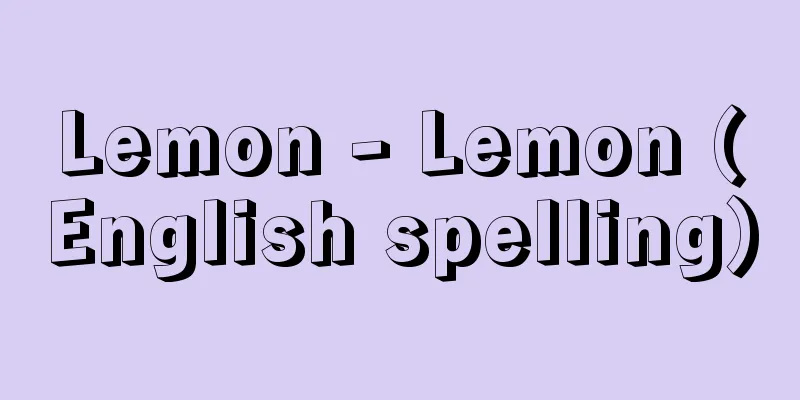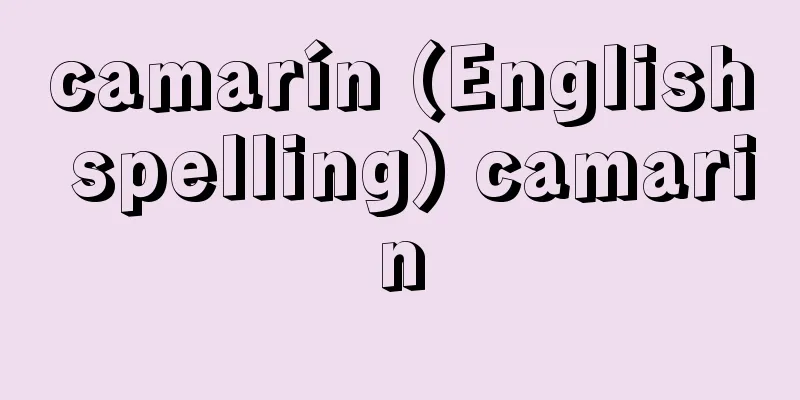Lemon - Lemon (English spelling)

|
An evergreen fruit tree of the Rutaceae family (APG classification: Rutaceae). A type of citrus fruit. It grows 4-5 meters tall, with leaves 10 cm long and 5 cm wide, without winged leaves. Flowers grow solitary or in a raceme at the ends of branches or in the axils, and are highly variable. The petals are long and large, purplish on the outside and white on the inside, with numerous, separated filaments and long anthers. It flowers all year round, but most of the flowers bloom from May to October. The fruit is mostly harvested from October to the following spring. However, in California, it is harvested all year round, with the peak season being January to May. The fruit is fragrant, weighs 120-200 grams, and has a pale yellow, soft skin. It is native to the eastern foothills of the Himalayas in India, and was introduced to Europe around the 12th century or around the time of the Crusades (late 13th century). It was brought to the New World on Columbus' second voyage (1493). It grows well in dry areas with a warm climate and little difference between summer and winter, and is widely cultivated in California and the Mediterranean region. In Japan, the summers are hot and humid, and the winters are too cold, making it difficult to cultivate due to the frequent occurrence of scab, canker, and cold damage. Major varieties include Eureka lemon, Lisbon lemon, Villafranca lemon, and Zenoa lemon. Japan imports approximately 50,800 tons of lemons annually, worth 11.9 billion yen (2017), mainly from the United States. [Muneo Iizuka October 16, 2020] useThe fruit keeps well after harvesting, and has long been revered by seafaring sailors to prevent scurvy. The main components of the fruit are 37 kcal, 9.6 g of sugar, 60 mg of calcium, 13 mg of phosphorus, 0.2 mg of iron, 4 mg of sodium, and 120 mg of potassium per 100 g of edible portion, and 0.06 mg of vitamin B1 , 0.03 mg of vitamin B2 , 0.2 mg of niacin, and 90 mg of C, with vitamin C being particularly effective. The juice contains a lot of organic acids (5.7-7.8%), especially citric acid, so it is not suitable for direct use as a dessert, but it can be squeezed over fish or meat dishes to enjoy its fresh aroma and sourness. It is also used as a soft drink in lemon squash and various cocktails. The fruit is sliced into rings or thin comb-shaped slices and garnished with various drinks and dishes. The outer peel is used to produce fragrant lemon oil, and the inner peel is used to produce pectin, which is used in medicines, cosmetics, and processed foods. It is also used as an ingredient in sweets when boiled in sugar. The juice is boiled with sugar to make jelly, and the peel and flesh are boiled in sugar to make marmalade. [Muneo Iizuka October 16, 2020] [References] | | | | | | | | |Green lemons picked early in Japan (top photo) and ripened yellow lemons (bottom photo) ©Shogakukan Lemon (domestic) Lemons picked early overseas turn yellow by the time they arrive in Japan ©Shogakukan "> Lemon (imported) Rich in vitamin C, it is used in cooking, medicines, health foods, cosmetics, etc. The harvest season is from autumn to the following spring. In Japan, it is cultivated mainly in Hiroshima Prefecture. ©Shogakukan "> Lemon fruit Source: Shogakukan Encyclopedia Nipponica About Encyclopedia Nipponica Information | Legend |
|
ミカン科(APG分類:ミカン科)の常緑果樹。柑橘(かんきつ)類の一種。高さ4~5メートル、葉は長さ10センチメートル、幅約5センチメートルで、翼葉がない。花は枝端や葉腋(ようえき)部に単生または総状につき、変異が多い。花弁は長くかつ大きく、外面は帯紫色、内面は白色で、花糸は多数で分離し、葯(やく)は長い。周年開花性があるが、5~10月の開花が多い。果実の収穫は10月から翌春に多く行われる。しかし、アメリカのカリフォルニアでは周年収穫され、1~5月が最盛期である。果実は香気に富み、120~200グラム、果皮は淡黄色で柔らかい。原産地はインドのヒマラヤ山脈東部山麓(さんろく)で、12世紀ころまたは十字軍の東征のころ(13世紀末)ヨーロッパに伝わった。「新大陸」へはコロンブスの第二航海時(1493)にもたらされた。 周年、気候温暖な、夏冬の格差の少ない乾燥地でよく育ち、カリフォルニアや地中海地方で多く栽培される。日本は、夏は高温多湿、冬は低温すぎるので、そうか病、かいよう病、寒害などが多く現れ、栽培はむずかしい。主要品種には、ユーレカレモン、リスボンレモン、ビラフランカレモン、ゼノアレモンなどがある。日本では年間約5万0800万トン、119億円(2017)を、主としてアメリカから輸入している。 [飯塚宗夫 2020年10月16日] 利用果実は収穫後の日もちもよく、昔から遠洋の船員の壊血病予防に尊ばれた。その主成分は、全果の場合、可食部100グラム中、37キロカロリー、糖9.6グラム、カルシウム60ミリグラム、リン13ミリグラム、鉄0.2ミリグラム、ナトリウム4ミリグラム、カリウム120ミリグラムを含み、ビタミンはB10.06ミリグラム、B20.03ミリグラム、ナイアシン0.2ミリグラム、C90ミリグラムを含み、ビタミンCの効果はとくに大きい。果汁は有機酸(5.7~7.8%)、とくにクエン酸を多く含むので、デザートとしての直接利用は不向きであるが、魚・肉料理などに絞りかけて新鮮な香りと酸味を楽しむ。また清涼飲料としてレモンスカッシュや種々のカクテルに用いる。果実は輪切りか、櫛(くし)形の薄切りにし、種々の飲み物や料理に添える。果皮は外果皮から芳香があるレモン油、内果皮からペクチンがとれ、薬品、化粧品、または加工食品に付与され、また砂糖煮にして菓子の材料とする。果汁は加糖して煮てゼリーとし、果皮と果肉を砂糖煮にしてマーマレードをつくる。 [飯塚宗夫 2020年10月16日] [参照項目] | | | | | | | | |日本で早摘みしたグリーンレモン(写真上)と追熟したイエローレモン(同下)©Shogakukan"> レモン(国産) 海外で早摘みしたレモンは、日本に入るまでに黄色くなる©Shogakukan"> レモン(外国産) ビタミンCが豊富で、料理のほか、薬品や健康食品、化粧品などに利用される。収穫期は秋から翌春。日本では広島県を中心に栽培されている©Shogakukan"> レモンの果実 出典 小学館 日本大百科全書(ニッポニカ)日本大百科全書(ニッポニカ)について 情報 | 凡例 |
Recommend
Large Nishiki
〘Noun〙 Large-format nishikie. It refers to a piece...
Anami-sama - Annamiyou
…According to the literature, his last work was t...
Tyrannus forficatus
…The male of the red flycatcher Pyrocephalus rubi...
Evening newspaper
A newspaper published in the evening. Most modern...
Flamininus, Titus Quinctius
[Born] Around 227 B.C. [Died] 174 BC. Rome. Roman ...
round brilliant cut
…(2)To cut a diamond, it is first split using cle...
Agricultural books
Agricultural books from before agriculture was est...
Japanese name - Wamei
This refers to the common Japanese name given to ...
Aspasia - Aspasia (English spelling)
Date of birth and death unknown. A courtesan born...
Cashew Resin Varnish - Cashew Resin Varnish
…The coating is strong and chemically resistant, ...
Haematobia irritans
...They are active during the day and rest on nea...
Printing expression
…Printing technology developed greatly with the i...
Living things -
It refers to something that has attributes that d...
Kakko - Bracket
(1) Chinese and Japanese membranophonic instrument...
Kamo no Tadayuki
Year of birth: Year of birth and death unknown. A ...









